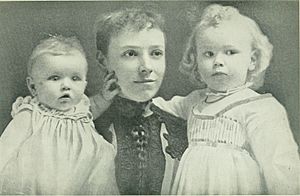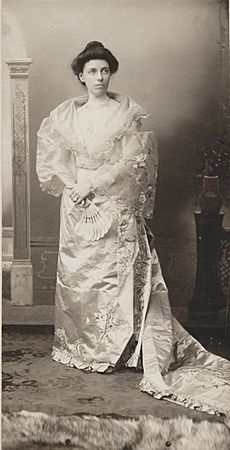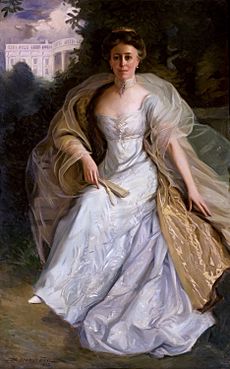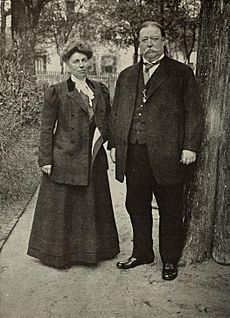Helen Herron Taft facts for kids
Quick facts for kids
Helen Herron Taft
|
|
|---|---|
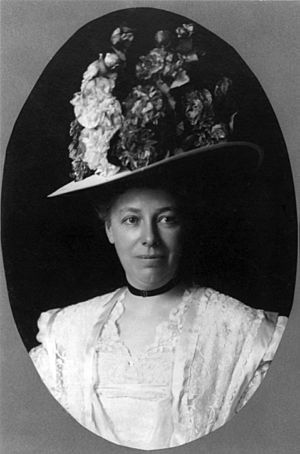
Taft in 1908
|
|
| First Lady of the United States | |
| In role March 4, 1909 – March 4, 1913 |
|
| President | William Howard Taft |
| Preceded by | Edith Roosevelt |
| Succeeded by | Ellen Wilson |
| Personal details | |
| Born |
Helen Louise Herron
June 2, 1861 Cincinnati, Ohio, U.S. |
| Died | May 22, 1943 (aged 81) Washington, D.C., U.S. |
| Resting place | Arlington National Cemetery |
| Spouse | |
| Children | |
| Education | University of Cincinnati |
| Signature | |
Helen Louise Taft (born Herron; June 2, 1861 – May 22, 1943), known as Nellie, was the First Lady of the United States from 1909 to 1913. She was the wife of President William Howard Taft. Nellie grew up in a family with strong political connections in Ohio. From a young age, she was interested in politics and decided at 17 that she wanted to become First Lady.
Nellie married William Howard Taft in 1886. She often guided him throughout his career, encouraging him to take steps that would help him become president. In 1900, she went with her husband to the Philippines. There, she became a well-known person in Manila and helped improve relations between the U.S. and the Philippines. When her husband became Secretary of War, she played a big part in convincing him to run for president in the 1908 United States presidential election. She also helped him make important connections to win the election.
As First Lady, Nellie Taft was deeply involved in the political side of the presidency. She often attended meetings and was her husband's closest advisor. She had a strong influence on his decisions, sharing her concerns and ideas about who should be appointed to government jobs. She also made changes to the White House staff and decorations. Inspired by her time in the Philippines, she turned the White House lawn and West Potomac Park into lively places with shows and events. Her idea to plant cherry trees in the park was a huge success, creating a popular spot for visitors. However, her influence as First Lady was cut short when she became ill two months into her time in the White House. This illness limited her movement and kept her away for a year while she recovered.
Even though President Taft was glad his term ended, Nellie was sad about his loss in the election. After leaving the White House, she remained active. She supported the Red Cross during World War I and took part in activities for the Colonial Dames of America. She became a widow in 1930. After her death in 1943, she was buried next to her husband in Arlington National Cemetery.
Contents
Early Life and Ambition
Childhood Years
Helen Herron was born on June 2, 1861, in Cincinnati, Ohio. She was the fourth of eleven children. Her parents were Harriet Collins Herron and lawyer John Williamson Herron. Everyone called her "Nellie." Her father knew two future presidents: Benjamin Harrison and Rutherford B. Hayes. Her mother's father and brother were U.S. congressmen. Growing up around politics, Nellie loved the excitement of campaigns. She also had a talent for music and became good at playing the piano.
Nellie had many siblings, and eight of them lived to adulthood. This made family life complicated for her. As a teenager, Nellie wanted to be independent and didn't always follow what society expected of upper-class women. She went to the Miss Nourse School for Girls in Cincinnati, where she learned many subjects, including several languages. She also attended Miami University and briefly the University of Cincinnati.
Nellie became interested in law when she was young, often reading her father's law books. In 1877, she visited President Hayes at the White House with her parents. This visit made her strongly wish to return to the White House as First Lady. She often shared this dream with her future husband.
Starting a Career and Meeting William Taft
Nellie Herron wanted to leave Ohio because she felt there weren't many opportunities for her there. She didn't think marriage should be a woman's main goal. As a young adult, she worked in her father's law office. She enjoyed her social events, even though she thought they were not very important. Nellie wished for more career choices as a woman. She ended up teaching French at a private school in Walnut Hills, Ohio, for two years starting in 1881. She didn't enjoy teaching much. She also wanted to write or perform music, but these didn't become her career.
Nellie first met William Howard Taft at a sledding party in 1880. Their families already knew each other. They later performed together in a community theater group. In 1884, Nellie started a group to discuss interesting topics every Sunday afternoon. She invited William Taft and his brother Horace. William Taft began to spend time with Nellie, taking her to dances and sending her letters and flowers. Nellie was unsure about committing to Taft, worrying if he truly cared for her. Taft proposed to her several times. She finally said yes in June 1885 but asked him to keep their engagement a secret.
Marriage and Family Life
Becoming a Married Couple
Nellie Herron married William Howard Taft on June 19, 1886. They went on a honeymoon to Europe, spending three months in England before visiting Germany and Italy. Nellie managed their travel budget carefully. After they returned, her husband borrowed money to build a home for them in Walnut Hills. They lived with his parents until their house was ready.
Nellie and William shared a strong emotional and intellectual connection. They valued each other's ideas. William welcomed Nellie's opinions, even when she thought he was wrong, calling her his "best critic." Nellie sometimes acted like a mother to him. He usually followed her advice, though she couldn't convince him to live a healthier lifestyle or control his weight. William Taft thought Nellie was the politician of the family. Early in their marriage, he even expected her to have a more successful political career than his own. Nellie managed the family's money and encouraged her husband's political career, pushing him toward the executive branch instead of his preferred path in the judiciary.
Nellie worried about their political future when her husband accepted a five-year term on the Cincinnati Superior Court in 1888. But she felt hopeful after he was appointed Solicitor General of the United States in 1890. She had helped him get this job through her connection with President Harrison. She saw their move to Washington, D.C. as a chance to escape Cincinnati, where she had felt limited. She hoped her husband would make important connections in Washington politics. She helped him improve his public speaking skills for his new role. She also became a popular socialite in the city and often attended Congressional meetings, which helped her build political connections.
They returned to Cincinnati in 1892 when William Taft became a judge on the federal circuit. He liked this job, but Nellie again worried it would stop his career progress. While her husband was a judge, Nellie raised their three children: Robert (born 1889), Helen (born 1891), and Charles (born 1897). During this time, she helped start a hospital and founded the Cincinnati Orchestra Association, serving as its president. She found Cincinnati lacked excitement, with her only break being a vacation home in Murray Bay, Quebec.
Life in the Philippines
In 1900, William Taft was sent to help set up a government in the Philippines. Spain had given the Philippines to the United States the year before. Nellie encouraged him to take the job, even though they didn't know exactly what it would involve. She was excited about the chance to travel and experience new things, stopping in Hawaii and Japan on the way. She also believed this position would bring him closer to the presidency. Once in the Philippines, Nellie tried to win over the Filipino people and respect their culture. She learned some of the language, wore traditional Filipino clothes, and invited Filipinos to social events. Her actions helped improve relations with the country, including working to end racial segregation that had been in place.
Nellie traveled widely throughout the Philippines, even learning to ride a horse to do so. She also went with her husband on official trips to China, Japan, and Hong Kong. She felt her main job in the country was to host large events where she could meet and talk with the Filipino people. Her husband became Governor-General of the Philippines on July 4, 1901. The Tafts then moved into the Malacañang Palace in Manila. While there, Nellie organized a program to provide milk for Filipino children. When she wrote her autobiography years later, most of it was about her time in the Philippines, even more than her time in the White House.
The Tafts left the Philippines for a trip home on December 24, 1901. This winter was hard for Nellie. She was tired from the constant stress of her role. Her husband needed two surgeries, and both of her parents had strokes, with her mother's being fatal. Nellie went with her husband on a trip to Italy in 1902. There, she was treated as an honored guest and met Pope Leo XIII. She returned to the Philippines in September 1902. In 1904, President Theodore Roosevelt offered William Taft the job of Secretary of War. Nellie convinced him to accept, and the Tafts moved back to Washington, D.C.
Wife of a Cabinet Member
Nellie Taft became a cabinet member's wife when her husband became Secretary of War. In this role, she was expected to visit and host other cabinet members' wives in Washington. She felt this position was less important than her time in the Philippines, where she had been the wife of the chief executive. This also meant she was often in contact with First Lady Edith Roosevelt, and they developed a rivalry. At the same time, Nellie encouraged and helped her husband build a close political and personal friendship with President Roosevelt. His work in the Department of War allowed for more travel. This gave Nellie a chance to learn about international politics and make connections abroad. The couple traveled together to Panama and Japan. She also took their children on a vacation to England while her husband stayed behind.
William Taft's career faced a big decision in 1906. President Roosevelt thought about nominating him for a spot on the Supreme Court. At the same time, more and more people thought William Howard Taft should run for president. Nellie was strongly against her husband taking a Supreme Court position. She feared it would end his political dreams. She met with President Roosevelt herself and talked to him for half an hour, discouraging him from nominating her husband. Nellie had spoken to the president many times, earning his trust to help her husband's position in the Roosevelt administration. This eventually led to Roosevelt supporting William Howard Taft for president. Roosevelt even planned political strategies with Nellie, not just with her husband, as the 1908 presidential election got closer.
By 1907, William Taft was seen as a possible presidential candidate. The Tafts traveled across the country on a speaking tour. Nellie found the experience more intense than she expected. She was embarrassed by one incident where she lost track of the week and was seen playing cards with her husband on a Sunday. Afterward, they returned to the Philippines and visited other countries. When they came back to the United States, Nellie chose not to join her husband's campaign. However, she did advise him during his campaign. She closely followed news coverage to know about any criticisms against him. She also advised him on how his decisions as Secretary of War would affect public opinion.
First Lady of the United States
Life in the White House
Nellie Taft saw her husband's election as president in 1908 as a personal victory, as she had guided him toward the office. She eagerly planned for the upcoming inauguration and her time as First Lady, including how she would manage the White House. She even had her inaugural dress sent to the Philippines to be embroidered there. President Roosevelt was not available on the day of President Taft's inauguration. So, Nellie decided she would ride to the White House with her husband in Roosevelt's place. She was the first presidential wife to do this.
When she moved into the White House, Nellie had it redecorated. She removed the trophy heads that Theodore Roosevelt had put on the walls. She made several other changes, taking ideas from Eastern cultures and using flowers from the White House greenhouse. She had twin beds put into the White House for the first time. She also made special arrangements for the White House silver collection, installing a vault and a silver cleaner. She changed the staff, replacing the ushers with footmen and the steward with a housekeeper. Nellie was very strict about cleanliness and how the White House looked. Journalists at the time praised her decorating skills.
In May 1909, shortly after her husband's term began, Nellie Taft became very ill. This affected her ability to speak and move her right arm and leg. She left Washington to recover. Newspapers reported that she had suffered a health setback. For the next year, Nellie had to relearn how to speak. She took a less active role after her illness, but she still stayed involved in White House matters. Although her condition improved over time, she never fully recovered. The details of her illness were not shared with the press, following a tradition of not discussing the First Lady's private life.
White House Hostess and Social Life
Nellie Taft had enjoyed the special treatment she received in the Philippines. She wanted to create a similar grand atmosphere as the White House hostess. She aimed to improve the social traditions at the White House. She changed where events were held to make them more efficient and introduced dancing at formal receptions. She made great use of the White House lawn, hosting garden parties, plays, and music performances. While she was recovering from her illness in 1909, Nellie took a less active role in organizing events. Her sisters and daughter helped her with the duties of White House hostess. She resumed her responsibilities in 1910 and was back to a busy schedule by 1911. Nellie hosted many parties and social events. The biggest social event of her time as First Lady was the Tafts' silver wedding anniversary gala on June 19, 1911, which had nearly 5,000 guests. Another 15,000 people gathered outside the White House.
Nellie Taft showed her independence as First Lady. She chose not to attend luncheons with the wives of cabinet members. She felt these were not important and just a way to sideline women. Instead, she observed presidential meetings and carefully managed the White House. She believed the presidential salary of $75,000 was more than they needed. She reduced their spending to $50,000 per year, saving $100,000 by the end of her husband's term. To save money, she bought food wholesale and kept a cow on the White House grounds for milk and butter. The cow's presence was not very popular.
As First Lady, Nellie Taft welcomed guests three afternoons a week in the Red Room. She started a White House tradition of having musical entertainment after state dinners. The Tafts attended symphony, opera, and theater performances in Washington D.C. She also started another summer tradition at West Potomac Park with the United States Marine Band playing for the public. A major project during Nellie Taft's time as First Lady was turning West Potomac Park into a beautiful public walkway. Inspired by Luneta Park in Manila, she had a bandstand built and organized weekly concerts. She also arranged for the planting of Japanese cherry trees. She accepted a gift of trees from the mayor of Tokyo, who was a friend of the Tafts. The Potomac cherry trees became a very popular tourist attraction, especially when they bloomed.
Prohibition was a big political issue while the Tafts lived in the White House. Nellie Taft was against the Prohibition movement. She served alcohol to White House guests, even though the president did not want her to. Unlike most other First Ladies, Nellie would visit the White House kitchens and watch the food being prepared. She especially watched the preparation of one of her favorite dishes, turtle soup. As First Lady, Nellie Taft also oversaw the replacement of horse and buggy transportation with the first presidential car fleet. She was open with the press and broke tradition by actively giving interviews. She especially worked with women journalists to support their work and gain their help. In 1912, she donated her inauguration gown to the National Museum of American History to start the First Ladies' Gown display, one of the Smithsonian’s most popular exhibits.
Political Influence
Nellie Taft was interested in everything about her husband's presidency. She had her own strong opinions on important matters. Even though she didn't think women should "meddle" in politics, she spoke publicly about her beliefs, even when they were different from her husband's. She managed his appearance and schedule to make sure he looked and acted properly. She would also give him political information like names and facts when he needed them. She would stay near him to prevent him from getting too tired during important moments.
Nellie Taft also influenced who her husband appointed to government jobs. She shared her thoughts on the people he nominated. She convinced her husband to remove ambassador Henry White because of a past disagreement she had with him. She also did not approve of Nicholas Longworth being appointed as a diplomat because he was married to Alice Roosevelt Longworth, whom she disliked. This action is seen as one reason why Presidents Roosevelt and Taft started to disagree during the Taft presidency.
Even though Nellie Taft did not call herself a feminist, she supported women's rights. She used her position to help the cause, convincing her husband to appoint women to government roles. In 1912, she attended a House Rules committee meeting to hear stories about police brutality against women, helping to bring attention to the issue. She also supported the rights of African Americans and other groups who faced challenges. She believed they were held back by a lack of opportunity. She was active in other causes, like safe workplace conditions, throughout her time as First Lady. Her illness at the start of her term prevented her from doing more political work, which she regretted. Her husband recognized her influence in White House politics, seeing his presidency's achievements as hers too. She also openly spoke about her own influence on the presidency, which led to some criticism from her husband's political opponents.
Nellie Taft was the first First Lady to visit the American judiciary. In 1911, she visited the Supreme Court of the United States to hear the arguments of Standard Oil Co. of New Jersey v. United States. She also asked to watch the inauguration of new Supreme Court justices, becoming the first woman to ever sit in the bar of the court. In June 1912, she attended both the Republican National Convention that re-nominated her husband and the Democratic National Convention that nominated his opponent Woodrow Wilson. She sat in the front row at the latter convention to try and stop speakers from criticizing her husband. Even though her husband did not enjoy being president, Nellie was sad when he lost the election to Woodrow Wilson in the 1912 presidential election. She left the White House unwillingly.
Later Life and Legacy
Life After the White House
After leaving the White House, the Tafts moved to New Haven, Connecticut. William Taft became a professor at Yale University. Nellie was not happy with life outside the White House. She was often alone when her husband traveled and her children were away at school. However, she was glad to be out of the public eye. In 1914, Nellie Taft became the first First Lady to publish a memoir, called Recollections of Full Years. She wrote it with her daughter Helen and journalist Eleanor Egan. She was interested in the events of World War I, and during the war, she supported the American Red Cross.
The Tafts continued to travel after leaving the White House. They visited Bermuda, Panama, England, and Italy. In England and Italy, they were greeted by King George V and the Pope. Continuing her interest in politics, Nellie Taft joined the Colonial Dames of America in 1923. She became its honorary vice president in 1925. She also served as the honorary leader of the Girl Scouts of the USA.
Nellie Taft became a widow on March 8, 1930. In her final years, she lived with her housekeeper in Washington, D.C., sometimes traveling to other countries. She continued to follow politics later in life, disagreeing with the New Deal policies of the 1930s. Nellie Taft died in Washington on May 22, 1943. She was buried next to her husband at Arlington National Cemetery.
Nellie Taft's Impact
Nellie Taft was one of the first First Ladies to be directly involved in her husband's political career. Her influence in presidential politics was not widely studied by historians after her death in 1943. Like other First Ladies, her impact was not closely examined until the 1980s. Before this, she was mostly known for introducing the cherry trees in West Potomac Park. The first biography about Nellie Taft was written in 2005 by Carl Sferrazza Anthony. He argued that she was her husband's closest advisor and felt responsible for the presidency as much as her husband did. Her role as a mentor and guide to her husband was recognized by journalists at the time and has become a key part of her legacy. She is remembered for her role in helping her husband's political career and bringing about the presidency of William Howard Taft.
See also
 In Spanish: Helen Herron Taft para niños
In Spanish: Helen Herron Taft para niños


